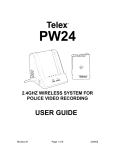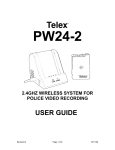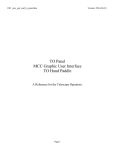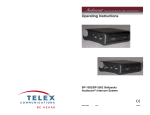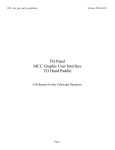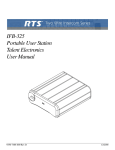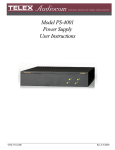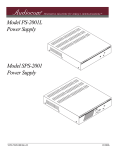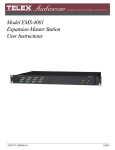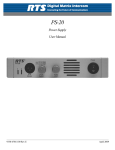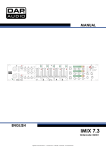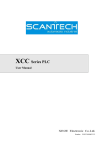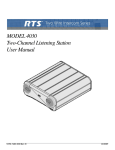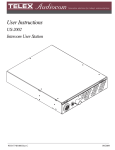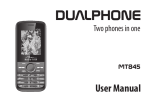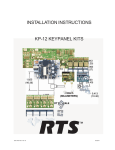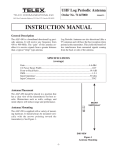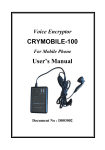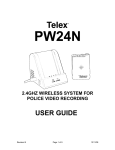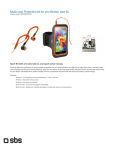Download BP-319 & BP-351 User Manual
Transcript
User Manual BP-319 / BP-351 User Station 9350-7753-000 Rev G 08/2007 BP-319 / BP-351 User Station BP-319 / BP-351 User Station THIS PAGE LEFT INTENTIONALLY BLANK BP-319 / BP-351 User Station BP-319 / BP-351 User Station PROPRIETARY NOTICE RETURN SHIPPING INSTRUCTIONS The product information and design disclosed herein were originated by and are the property of Telex Communications, Inc. Telex reserves all patent, proprietary design, manufacturing, reproduction, use and sales rights thereto, and to any article disclosed therein, except to the extent rights are expressly granted to others. Customer Service Department Telex Communications, Inc. (Lincoln, NE) Telephone: 402-467-5321 Fax: 402-467-3279 Factory Service: 800-553-5992 Please include a note in the box which supplies the company name, address, phone number, a person to contact regarding the repair, the type and quantity of equipment, a description of the problem and the serial number(s). COPYRIGHT NOTICE Copyright 2006 by Telex Communications, Inc. All rights reserved. Reproduction, in whole or in part, without prior written permission from Telex is prohibited. SHIPPING TO THE MANUFACTURER All shipments of product should be made via UPS Ground, prepaid (you may request from Factory Service a different shipment method). Any shipment upgrades will be paid by the customer. The equipment should be shipped in the original packing carton. If the original carton is not available, use any suitable container that is rigid and of adequate size. If a substitute container is used, the equipment should be wrapped in paper and surrounded with at least four (4) inches of excelsior or similar shockabsorbing material. All shipments must be sent to the following address and must include the Proof of Purchase for warranty repair. Upon completion of any repair the equipment will be returned via United Parcel Service or specified shipper, collect. Factory Service Department Telex Communications, Inc. 8601 East Cornhusker Hwy. Lincoln, NE 68507 U.S.A. Attn: Service WARRANTY NOTICE See the enclosed warranty card for further details. CUSTOMER SUPPORT Technical questions should be directed to: Customer Service Department RTS/Telex Communications, Inc. 12000 Portland Avenue South Burnsville, MN 55337 USA Telephone: 800-392-3497 Fax: 800-323-0498 Figure 7 - Connector Plate Assembly, BP351 - 90207486000 14 3 BP-319 / BP-351 User Station BP-319 / BP-351 User Station 6 Description 7 17 2 The BP-319/351 are beltpacks for use with RTS 2-wire intercom systems. The BP-319 is a microprocessor controlled one-channel intercom, where the BP-351 is a microprocessor controlled two-channel select intercom beltpack. Both have connections for headset/earset microphones (Dynamic/Electret). 25 Features Features of the BP-319/351 include: Microprocessor controlled Microphone Kill Detect. J2 • • • 5 Call function that allows the user to send or receive call signals to other devices on the intercom channel, including Audible Call Alert on the listen side. 4 • Powered externally, via the intercom system power supply on channel one. Headset/earset 4 or 5-pin XLR connection set for intercom operation. J1 12 18 (2PLS) Connections and Controls 3 BP-319/351 has the following connections and controls: 19 • A loop-through connection connects several beltpacks in a chain. Since this is often the preferred method of connection, a line loop connector has been added to new units. See Figure 1). Headset connectors that accept XLR type 4 or 5-pin male connector. 13 Intercom volume control. (2PLS) • • • Line connector that accepts an XLR type 3-pin male connector for intercom line and power input. S RT 14 (2PLS) 15 (2PLS) 8 TOJ1 1 -35 BP 1 24 TOJ2 18 (4PLS) 11 9 26 27 4 13 10 Figure 6 - BP351 Final Assembly 9010-7754-000 BP-319 / BP-351 User Station BP-319 / BP-351 User Station Specifications General Channel Supplied Power Requirements: 30 VDC nominal (standard RTS line), 40 to 100 mA. Environmental Requirements: Storage: -20°C to 80°C; to 95% humidity, non-condensing Operating: 0°C to 50°C; 0% - 95% humidity, non-condensing. Dimensions: 4.75” (120.7 mm) H x 3.5” (95.3 mm) W x 1.6” (40.6 mm) D Weight: Approximately 13 oz. (364 g). Interface Requirements Headset/Earset: 50 to 200 Ω dynamic microphone 150 to 600 Ω headphones 1000-3000 Ω electret microphone RTS Intercom Channel: Foil Side Output Level: 775 VRMS nominal Terminating Impedance: 200 Ω ±5% Bridging Impedance: greater than 10,000 Ω. Call Signaling: Send 20kHz ±100Hz, 250 mVRMS ±10% Receive 20kHz ±800 Hz, 100 mVRMS ±10% Mic-Off Frequency Detect: 24kHz ±800Hz, 100 mVRMS Noise Contribution less than -60 dB on the line. Headphone Amplifier Maximum Output: 4.5 ±10% VRMS into 150Ω headphones Frequency Response: 200Hz to 8kHz ±2dB Audible Alert: 1kHz, at the headset/earset Component Side Total Harmonic Distortion Less than 1% nominal at less than 3.5 VRMS into the headset Figure 5. PC Board Assembly BP-319 and BP-351 12 5 BP-319 / BP-351 User Station BP-319 / BP-351 User Station Connector Pin Configurations Intercom Channel Connector XLR-3 M/F Loop Thru BP-319 Pin 1 Common Pin 2 BP-351 Common +30VDC IN/ System Chan 1 +30 VDC IN/ System Chan 1 Pin 3 System System Chan 2 Chan 2 NOTE: On BP-319 channel must be select by intercom jumpers see page 8. Headset Connector Type: XLR-4F Pin 1 Headset microphone low Pin 2 Headset microphone high Pin 3 Headphone common Pin 4 Headphone Audio Type: XLR-5F Pin 1 Headset microphone low Pin 2 Headset microphone high Pin 3 Headphone low Pin 4 Headphone high Pin 5 No Connection ** Sometimes pin 4 and 5 connect together when using a dual-sided headset. Figure 4 -Connector Plate Assembly, BP319 - 90207486000 6 11 BP-319 / BP-351 User Station BP-319 / BP-351 User Station 7. Intercom Channel Connector: The BP-319/351 intercom channel is connected via a 3-pin female connector with a 3-pin male loop through NOTE: The numbers refer to the callouts in connector. The BP-319/351 is powered Figure 1. from the intercom system power supply. 1. Volume Control: Use this control to adjust the headset/earset listen level. 6 2 OPERATION EXTERNAL CONNECTIONS & CONTROLS 7 17 2 24 4 J2 5 J1 (2PLS) 12 18 3 19 13 (2PLS) S RT 14 (2PLS) 15 (2PLS) 3. Call Button and Indicator: The Call function allows the user to send or receive signals to/from other devices on the intercom channel selected. The Call button operates in two ways: Call Receive: When there is an incoming call signal, the indicator is red. (If Audible Call Alert is enabled, incoming calls will cause beeps in the headset.) Call Send: To send a call signal to all stations on a selected channel, press and hold the Call button until a verbal response is received. The indicator will glow red. 4. Talk Button and Indicator: The talk button activates the headset microphone and operates in two ways: Latched Mode: Tap the button once to talk. The indicator will glow green. Tap the button again when finished with a conversation. Momentary Mode: Press and hold the button to talk momentarily. Release the button when finished talking. 8 TOJ1 9 -31 BP 1 23 TOJ2 18 (4PLS) 11 9 10 25 26 Figure 3 - BP319 Final Assembly, 90107753000 10 2. Chan Select Button (BP-351 only):The Chan button allows the user to select which intercom channel is active. The yellow indicator next to 1 or 2 lights to show the active channel. Press the Chan button to change the channel selection. 5. Sidetone Control: When using a headset, this control adjusts your own voice level heard in the earphones. To adjust the level, tap the Talk button once to turn ON the headset microphone. Then, use a small flathead screwdriver to increase or decrease your voice level while talking into the microphone. (This control is accessible by removing one screw of the belt clip.) Figure 1 - Reference View SETTING MODES OF OPERATION Perform the following steps to change the BP-319-351 mode of operation. 1. Both the Talk and Call indicators should be off. 2. Press and hold both the Talk and Call keys, then release both keys. The Call indicator should now glow red. (The number of beeps heard in the headset indicates the current mode of operation.) 3. Press the Call key to change to the next mode of operation. Each press of the Call key causes the BP-319/351 to change to the next mode of operation. 4. When the desired mode is reached, press the Talk key to select the mode and exit. NOTE: Each time the intercom system power is turned ON, the BP-319/351 will reset, the BP-319/351 will reset to the default mode of operation (Mode 2, see Table 1. 6. Headset Connector: This connector accepts an RTS boom microphone. 7 BP-319 / BP-351 User Station MODE (beeps) MIC KILL AUDIBLE CALL ALERT 1 Disabled Disabled 2 (Default) Enabled Disabled 3 Disabled Enabled 4 Enabled Enabled BP-319 / BP-351 User Station To adjust the level of your own voice heard in the earphones, tap the Talk button once to turn on the headset microphone. Then, use a small flathead screwdriver to increase or decrease your voice level while talking into the microphone. Mic Gain Adjustment Table 1. Operating Modes 3 Replacement Parts Where To Obtain Parts Parts may be obtained directly from Telex at: Telex Communication, Inc. (Lincoln, NE) Telephone: 402-467-5321 Fax: 402-467-3279 Factory Service: 800-553-5992 The Mic Gain adjustment is accessible internally on the board (R156) See Figure 2. BP-319-351 OPERATION PROGRAMMING To adjust the Mic Gain, do the following: The BP-319/351 uses four modes of operation to control the Mic Kill and Audible Call Alert features (see table 1, page 8). Using a Phillips head screw driver, turn the Mic Gain pot clockwise to increase the gain (or counterclockwise to decrease the gain). Mic Kill: When this feature is enabled and a Mic Kill signal is received from the intercom channel, the BP-319/351 microphone will be turned off. Audible Call Alert JP2 D SW1 BALJP3 When this feature is disabled, no audible beep is heard for incoming calls. D JP1 When this feature is enabled, an audible beep is heard in the headset whenever there is an incoming call from the same intercom channel. R156 UBL R145 U7 There are several internal switches, jumpers and adjustments that affect operation. These are described below. To gain access to the switches, jumpers, and adjustments, disconnect all power and line connections. Remove two screws from the top of each side of the case and two screws from the bottom of each side of the case. The jumper and switch locations are shown in Figure 2. R13 SW5 INTERNAL SWITCHES, JUMPERS, AND ADJUSTMENTS SW4 SW3 Figure 2. Internal Jumpers and Switches J u m p er Sw i t c h Nu m b e r Sidetone Adjustment The side tone adjustment is accessible either internally (see Figure 2) or by removing the belt clip mounting screw shown in Figure 1. J u m p er o r Sw i t c h Fu n c t i o n Def au l t Set t i n g JP1 & JP2 Must be connected to Pins 2&3 Pins 2 & 3 shor ted JP3 (BP-319) Pin 1 & 2 shor ted for CH1 audio Pins 1 & 2 shor ted Pin 2 & 3 shor ted for CH2 audio JP3 (BP-351) Pins 2 & 3 shor ted at all times. Pins 2 & 3 shor ted. Table 2. Internal Jumpers 8 9








